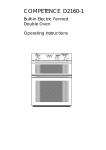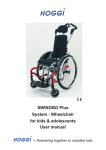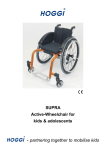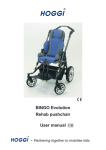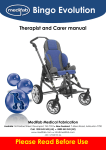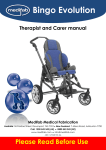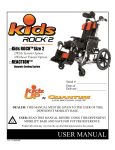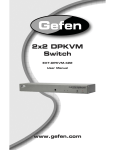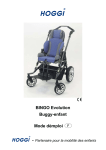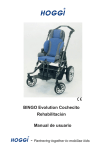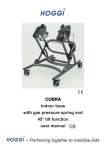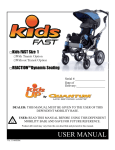Download FARO - User manual
Transcript
.d e w w w . FARO - User manual Active folding wheelchair for kids & adolescents Partnerschaft für mobile Kinder User manual FARO - active folding wheelchair for kids & adolescents 1 Model identification 1.1 Model identification (label)______________________________________________________ 3 1.2 Basic configuration___________________________________________________________ 3 2 Common Information 2.1 Preface____________________________________________________________________ 2.2 Application__________________________________________________________________ 2.3 Declaration of conformity_______________________________________________________ 2.4 Terms of warranty____________________________________________________________ 2.5 Servicing and repairs__________________________________________________________ 3 Safety instructions_______________________________________________________________ 5 3.1 Meaning of symbols__________________________________________________________ 5 3.2 Common safety instructions___________________________________________________5-8 4 Delivery and Preparing for use___________________________________________________9-12 4 4 4 4 4 5 Adjusting and adaptation possibilities _____________________________________________ 12 5.1 HOGGI light wheel locks______________________________________________________ 12 5.2 Seat width / Seat depth / Seat height / Seat angle / Backrest angle / Active degree / Camber_13 5.3 Nylon (seat-) cover/ Utility bag_________________________________________________ 14 5.4 Backrest height / Nylon (backrest-) cover_________________________________________ 15 5.5 Lower leg length____________________________________________________________ 16 5.6 Folding up the „standard“ foot rest______________________________________________ 16 5.7 Angle adjustment of the “standard“ foot rest_______________________________________ 16 5.8 Height adjustment of the single push-handles_____________________________________ 17 5.9Anti-tip____________________________________________________________________ 17 5.10 Detaching wheels with quickrelease_____________________________________________ 18 5.11 Pneumatic tyres / PU-tyres____________________________________________________ 18 5.12 Hand rims_________________________________________________________________19 6Accessories____________________________________________________________________ 20 6.1 Seat cushion_______________________________________________________________ 20 6.2 Spoke guard_______________________________________________________________ 20 6.3 Single push handle(s), height adjustable_________________________________________ 20 6.4 Single push handle (s), displaced to the back & height adjustable______________________ 21 6.5Anti-tip____________________________________________________________________ 21 6.6 Tip assist__________________________________________________________________ 22 6.7 Calf strap__________________________________________________________________ 22 6.8 Lap belt___________________________________________________________________ 23 6.9 Arm-rest___________________________________________________________________ 24 6.10 Therapy-tray_______________________________________________________________ 24 7Transport______________________________________________________________________ 7.1 Folding FARO______________________________________________________________ 7.2 In the trunk (luggage space) of a car____________________________________________ 7.3 Using FARO for bus transport__________________________________________________ 7.4 Transfer - getting into or out of FARO____________________________________________ 25 25 26 26 26 8 Maintenance, care & service life___________________________________________________ 28 9 Technical data__________________________________________________________________ 29 2 1 Modellidentification and basic configuration 1.1 Model identification (label) (The label is placed on the (side)-frame, see the arrow marking) (Frame)-size Model (Frame)-size CE label Seat width Serial number Colour code Manufacturer Year of manufacture Maximum load / load capacity 1.2 Basic configuration - Folding active wheelchair / powder coated aluminium frame / new patented folding mechanism - 2 different size versions: Size 2: SW 28 - 36 cm in 2 cm steps, SD 26 - 38 cm Size 3: SW 32 - 40 cm in 2 cm steps, SD 30 - 42 cm - Seat heights, front: 36 cm to 49 cm - Seat angle: 0° up to 12° - Convertible to other seat widths - Backrest angle: adjustable from 80° up to 110° adaptable backrest cover - HOGGI light wheel locks - Double wall HOGGI light rear wheels incl. push rims with light weight tires, detachable by quick release axles - Wheel camber selectively 3°, 6° or 9° - Maximum load 100 kg 3 2 Common Information 2.1 Preface Thank you for selecting the FARO active folding wheelchair for kids & adolescents. We have designed this high-quality product to make your life safer and easier, and we’ve included this manual to help you use and care for it. Please read the following instructions to make sure you use this product as recommended. If you have any further questions, or if you have any problems, please contact your healthcare provider. We hope that FARO meets your expectations. The design, as described in these instructions for use, are subject to technical alterations without notice. 2.2 Application The FARO wheelchair is designed solely for individual indoor and outdoor use by persons who are unable to walk or who have a walking impediment, and can be operated by the patient or by another person. Assistance may be required due to: • Paralysis (paraplegia / tetraplegia or tetraparesis) • Muscle and nerve disorders • Loss of limbs (dysmelia/lower limb amputation) • Imperfect osteogenesis • Infantile/spastic cerebral palsy • Poliomyelitis • Spina Bifida 2.3 Declaration of Conformity HOGGI as manufacturer with sole responsibility declares that the FARO conforms to the requirements of the 93/42/EEC guidelines. 2.4 Terms of Warranty Warranty applies only when the product is used according to the specified conditions and for the intended purposes, following all manufacturer’s recommendations. The manufacturer is not responsible for damages caused by components and spare parts not approved by the manufacturer. Please see also § 8 of the AGBs at www.hoggi.de 2.5 Service and Repairs Service and repairs on the FARO should only be carried out by authorized HOGGI dealers. Should any problems arise, please contact the dealer who supplied your FARO. Authorized dealers only fit original HOGGI spare parts. For Preparing, repair and service, the following tools are required: - Water bubble - Allen wrench key: 3 mm, 4 mm, 5 mm und 6 mm - Socket wrench: 10 mm, 13 mm und 17 mm - Flat wrench: 8 mm, 10 mm, 11 mm, 13 mm, 17 mm, 19 mm und 24 mm 4 3 3.1 Safety instructions Meaning of symbols Caution! Warning of possible danger of accident and injury. Warning of possible technical damage. Information! About use of product. Information! For service-personnel. Attention! Read manual first! 3.2 Common safety instructions Read manual completely before use! Familiarize yourself with handling and functions of the wheelchair before use and practice the handling. You are responsible for the safety of your child. The safety of your child could be affected if you do not follow the instructions of this manual. Nevertheless not all possible circumstances and unpredictable situations can be covered by this manual. Reason, care and circumspection are not features of the product, they are required of persons, who use the wheelchair or attend it. The person, who is using the wheelchair and its accessories should understand all instructions. It must explained to every other person using the wheelchair and its accessories. If instructions are not clear and further explanations become necessary, or if you have further questions please contact your HOGGI dealer. Practise with the new wheelchair on even, straightforward terrain first, together with the child. Together with the child, learn how the wheelchair reacts when the centre of gravity shifts; for example on slopes or inclines or when clearing obstacles such as steps and curbs. This should be done only with assistance from another person. Using an anti-tip is strongly recommended for inexperienced wheelchair users. Strap in your child at all times, when it is in the wheelchair. HOGGI points out, that any use beside the typical use can be dangerous. The wheelchair is not suitable for jogging, running, skating or similar activities. Swivelling front wheels tend to wobble at higher speed, which can cause a sudden stop and tip over of the wheelchair. Use the wheelchair only at regular walking speed. Under no circumstances leave the handle bar while pushing and never push the wheelchair away. The wheelchair should only be used on solid level ground. 5 Use your wheelchair as intended by the manufacturer. For instance, do not drive into obstacles (including steps, curbs) without braking. Do not „jump” the chair down from higher surfaces. To clear obstacles such as steps and curbs, tilt the wheelchair onto the rear wheels (pull it backwards to go up; to descend, slowly lower it forward). If only one attendant is available when ascending or descending stairs, an incorrectly set anti-tip (if mounted at all) can lead to severe falls. Adjust the anti-tipper so that it does not come in the way of the steps during transport. Afterwards, swing the anti-tipper back to its operational position. Do not go up or down stairs without the assistance of another person. If devices such as ramps or elevators are available, please use them. Ensure that the anti-tip (if mounted) is outside the danger-area. If wheelchairfriendly access is missing, two attendants must carry the wheelchair over the obstacle. Fassen Sie den Rollstuhl zum Anheben nur an fest verschweißten bzw. fest verschraubten Rahmenteilen an (am Seitenrahmen oberhalb der Lenkräder und an den Schiebegriffen die an den Rückenrohren verschraubt sind - alternativ kann man auch bei geschlossenen Bremsen die Greifreifen verwenden). When ascending slopes or ramps and when crossing obstacles on upward slopes, always lean the wheelchair user‘s upper body far forward. When descending slopes, do not drive without braking and reduce your speed. Reduced load on the casters due to centre of gravity shifting can cause the casters to flutter. If you have to park on a slope, face the wheelchair uphill with the brakes engaged and ensure that the seat is in the upright position. There is a risk that the pushchair might tip over backwards if the seat is the reclined position. Before leaving the wheelchair and before getting into and out of it, always lock the wheel locks. Do not use any footplate to get in or out of the wheelchair. Depending on footplate settings and wheelchair geometry, the wheelchair may tip over if the user boards the chair using the footplate. First practise boarding the chair with the child and an attendant who can secure the wheelchair, and modify footplate and seat height settings if the chair has a tendency to tip over. In addition, turn the caster fork to the front prior to using the footplate for getting into the wheelchair; this increases the wheelbase and thereby the wheelchair‘s stability against tipping. The effectiveness of the wheel lock and the overall driving quality are dependent on adequate air pressure. With properly inflated rear wheels and even tyre pressure on both sides, your wheelchair is much easier to operate and manoeuvre. Before starting to use your wheelchair, check that the tyres are inflated correctly. The required air pressure is printed on the side of the tyre. For rear wheels, it should be at least 6 bar. All brakes acting on the tyres do not serve as service brake but are only designed as parking brake (wheel lock). The wheel locks must not be used as driving brakes for slowing down the wheelchair, as in extreme cases, the abrupt stopping of the wheelchair can lead to falls. Please keep packaging material away from children. Plastic packaging presents the danger of suffocation. 6 Disposal of waste: The packaging material as far as metal, aluminium and plastic parts can be recycled. The recycling must be operated according to the national and legal terms. Never leave your child unattended in the wheelchair even when they are strapped in and the brakes engaged. In the dark, the user should wear light clothing or clothing with reflectors in order to improve visibility. Ensure that the reflectors installed on the sides and rear of the wheelchair are easily visible. We also recommend installing active illumination. Extreme settings (e.g. shortest wheelbase and seat in the backmost position) combined with an unfavourable body posture can cause the wheelchair to tip even on level ground. Static stability is (with extreme settings e.g. active degree 5) <10° inclination. Use anti tips in that case necessarily. Attaching heavy bags or other weight to the push handles can adversely affect stability. Adjustments with a high active degree demand a practised driver and the use of anti tips. Under no conditions should the anti-tip(s) assume the function of transport wheels, for example to transport a person in the wheelchair with the rear wheels removed. The anti tips must audibly lock in place, before it is able to bear loads. Firm seating must be verified by the user or by an attendant. FARO is only intended to carry one child at a time. The maximum load for FARO is 100 kg. All accessories and add-ons reduce the maximum load proportionately. We recommend that, wherever and whenever possible, users transfer to the seats installed in the motor vehicle and use the corresponding vehicle restraint systems, because this is the only way to ensure optimum protection of the passengers in case of an accident. Your FARO is not admitted for use as a seat in a motor vehicle. Be careful in case of extreme temperatures. The wheelchair can heat up significantly when in the sun or in the sauna. In extreme cold, there is a risk of hypothermia. Slowing down from high speeds or when descending longer slopes tends to heat up the hands and fingers, especially if using aluminium push rings. When using the wheelchair outdoors, leather gloves should be worn. Gloves provide the wheelchair user with a better grip and protect his or her fingers from dirt and hot metal. Always make sure that the quick-release axles are correctly set on the rear wheel. It may not be possible to remove the rear wheel unless the button on the quick-release axle is pushed. The assembly of a seat shell is only permitted within the specified seating area. The manufacturer of that new product combination has to test the stability and the adherence of the maximum load before commissioning. Avoid reaching into any clamping range. Danger of clamping exist in following assembly groups: - Brake lever (if FARO is supplied with fender with integrated brake system) - Between brake lever and rear wheel (if FARO is supplied with brake HOGGI light FARO) 7 The HOGGI seat cushion (Trevira CS) and the contoured Sitzkissen (Trevira CS) as well as the HOGGI nylon seat- and backrest cover are referred to the EN 1021-1 and EN 10212 norm flame resistant. Please read to visually handicapped people the manual and info material - or use electric aids. Please download or read all FARO documents on our webside www.hoggi.de. Whenever you change any settings on the wheelchair, make sure that you firmly tighten any screws that have been loosened 8 4 Delivery and preparing for use Your FARO wheelchair will normally be supplied completely mounted with folded backrest and with removed front castors and rear wheels. (1). The original package contains the following parts: • Wheel chair with detached or folded push-bar / push-handle • Rear wheels and quick-release axles unmounted • Front castors already mounted in the front castor forks • Additional accessories as ordered • Instructions and list of tools required 1 Please remove the transport packaging carefully. To prepare the wheelchair for use please proceed as follows: • Grip the head of the quick-release axle as illustrated (2) and press the release knob. 2 • Whilst pressing the release knob, position the quick-release axle into the rear wheel bearing (3). 3 • Place the wheelchair onto the front castors and lift the wheelchair at the backrest tube or the push handle. • Insert the rear wheel and the quick-release axle into the axle housing. Hold the spokes (4) close to the wheel hub and press the release knob with your thumb. The rear wheel can then be easily slid into position. CAUTION! Push each rear wheel to check that each quick-release axle is safely located. 4 Unfolding FARO: • Step besides the wheelchair (5). • Activate the brakes (5). CAUTION! Avoid reaching into any clamping range. 5 9 • Secure the wheelchair with one hand on the side frame (6). 6 • Unfold the wheelchair with the other hand backwards (7). 7 • Move the backrest as shown until the locking bolts engage audibly. 8 • Check also visually if the locking bolts are engaged (9). 9 • Move the backrest cross bar as shown downwards (10). 10 10 • Move both footplates downwards (11). 11 Picture 12 shows an anti-tip in a „non-active“ position. 12 • To activate the anti-tip move the the anti tip with the foot downwards (13). 13 • Turn the anti-tip with the foot to the inside into the active position. 14 • The length of the tubes can be adjusted in three positions (with respectively 2,5 cm distance). • The anti tip should be adjusted that it is 2-3 cm above the ground. 15 11 If your wheelchair is supplied with HOGGI seat cushion, please proceed as follows: • Put the seat cushion on the seat-cover.(16). • Start from the back and fix it with the Velcro fasteners (16). 16 • Press the seat cushion equally and firmly on the nylon cover. (17) 17 5 Adjusting and adaptation possibilities 5.1 HOGGI light wheel locks • Press the brake lever below to lock the wheel lock (18). 18 CAUTION! All brakes acting on the tires do not serve as a slow down brake but are only designed as a parking brake (wheel lock). The wheel locks must not be used as driving brakes for slowing down the wheelchair, as in extreme cases, the abrupt stopping of the wheelchair can lead to falls. The brake shoe presses on the tires and grips it tightly. The brake shoe is, therefore, at a 90° angle to its holder (19). The brake shoe should overlap 3-5 mm to the middle of the wheel (19). 19 CAUTION! The effectiveness of the wheel lock are dependent on adequate air pressure. Before starting to use your wheelchair, check that the tires are inflated correctly. The required air pressure is printed on the side of the tires. For rear wheels, it should be at least 6 bar. • To release the wheel lock pull the brake lever upwards (20). 20 12 • When the wheel lock is released the distance from the brake shoe to the wheel should be 12-15 mm. • The distance of the brake shoe is adjustable. Use the marked adjustment screws. The wheel locks should be adjusted by a technician. 21 5.2 Seat width / Seat depth / Seat height / Seat angle / Backrest angle / Active degree / Camber FARO is available in seven, different seat widths starting from 28 - 40 cm. The seat width gets measured at the outer edges of the seat tubes (22). FARO wheelchair was built in accordance with the customer’s order. It is possible for the technician to modify the wheelchair with a different seat width. The seat depth is adjustable (with the seat tubes) in 2 cm steps (23). First the seat cushion and the seat nylon must be removed. (A=seat tube maximal - B=seat tube minimal) 22 B A FARO wheelchair was built in accordance with the customer’s order. It is possible for the technician to modify the wheelchair with a different seat depth. 23 The seat height (24) depends on the chosen size of rear- and front wheels as well as the height of the rear axle and the position of the front wheels in the castor. FARO wheelchair was built in accordance with the customer’s order. It is possible for the technician to modify the wheelchair with a different seat height. 24 The seat angle depends on the chosen size of rear- and front wheels as well as the height of the rear axle and the position of the front wheels in the castor. FARO wheelchair was built in accordance with the customer’s order. It is possible for the technician to modify the wheelchair with a different seat height. 13 25 The backrest angle is from 80° up to 110° adjustable. FARO was built in accordance with the customer’s order It is possible for the technician to modify the wheelchair with a different seat height. 26 The active degree describes the relation of the backrest position to the rear wheels. The more the backrest is positioned to the rear of the axle, the more active the FARO can be driven. That means contrary a safer driving. The active degree is adjustable in five steps (1-5). 27 FARO wheelchair was built in accordance with the customer’s order. It is possible for the technician to modify the wheelchair with a different active degree. FARO is available with 3° (28, left), 6° (28, right) or 9° (not pictured) camber. FARO wheelchair was built in accordance with the customer’s order. It is possible for the technician to modify the wheelchair with a different camber. 28 5.3 Nylon (seat)-cover and utility bag FARO wheelchair is supplied with a stretchable nylon seat cover and an utility bag under the front edge of the seat (e.g. for a wallet) • To stretch the nylon seat cover remove the seat cushion and loose the five fasteners (29). 29 We suggest to remove the utility bag before stretching. • Loose the Velcro fasteners and remove the bag (30). 30 14 • Loose the Velcro fasteners, stretch the nylon and fix the Velcro fasteners again (31). 31 • Tighten the fasteners (32). • Fix the utility bag. • Fix the nylon (seat)-cover. CAUTION! Whenever you change any settings on the wheelchair, make sure that you firmly tighten all screws that have been loosened. 32 5.4 Backrest height / Nylon (backrest)-cover The use of telescopic tubes offers the adjustment of the backrest height The telescopic tubes are available in two different sizes. • Take off the Nylon (backrest)-cover (33). • Choose your desired backrest height and adjust the height by inserting the telscopic tubes or use the height adjustment of the single push handles (see 5.8). 33 • If your FARO wheelchair is supplied with a preset backrest height there are further Velcro fastener included in the scope of delivery for positioning a higher backrest height. 34 • Post the self-adhesive fleece strip (included in the scope of delivery) in the now released space as shown in the illustrations (35). • Adjust the tension of the Velcro fasteners as desired. 35 15 • Fix the backrest cushion, starting from the front (36). 36 5.5 Lower leg length • Loose and remove the screw (37). 37 • The stepless adjustment of the „standard“ foot rests offers individual positions for the lower leg length (38). CAUTION! Whenever you change any settings on the wheelchair, make sure that you firmly tighten any screws that have been loosened. 38 5.6 Folding up the „standard“ foot rest We suggest to fold up the standard foot rest to get in or out of the wheelchair. 39 5.7 Angle adjustment of the „standard“ foot rest • Loose the screw as shown (40). 40 16 The angle of the „standard“ footrest is stepless adjustable. 41 • Tighten the fasteners (42). CAUTION! Whenever you change any settings on the wheelchair, make sure that you firmly tighten any screws that have been loosened. 42 5.8 Height adjustment of the single push handle(s) • Loose the fasteners as shown (43). 43 • Lift the single push handle into the desired position (44). • Tighten the fasteners. CAUTION! Whenever you change any settings on the wheelchair, make sure that you firmly tighten any screws that have been loosened. 44 5.9 Anti-tip • Adjust the angle of the anti tip to the ground after loosening the marked sccrew (45). 45 17 The length of the anti-tip is adjustable in three positions respetively in 2,5 cm steps (46). 46 On the anti tip tube are two positions selectable. The distance between both positions is 1,5 cm (47). 47 5.10 Detaching the rear wheels with quick-release axles The rear wheels are removed by means of a quick-release mechanism. This reduces the volume of the wheelchair for transportation: 48 49 49 • Tilt the wheelchair onto the front castors and lift it by holding the rear edge of the seat. • Grip the spokes close to the wheel hub and, with the thumb, press the release knob of the quick- release axle. • Pull the rear wheel with the quick-release axle out of the axle housing. • To avoid a risk of snagging, it may be preferable to withdraw the quick-release axles from the rear wheels. • To re-assemble the rear wheels refer to section 4 “Delivery and preparing for use”. CAUTION! Push sharply on each rear wheel to ensure that the quickrelease axles are securely located. 5.11 Pneumatic tires / PU-tires The rear wheels can be supplied with pneumatic tires (61, left). The car type valves enable the tyres to be checked or inflated at any petrol station or by means of a suitable pump, supplying a minimum 6 bar pressure (50). Check the maximum tire pressure, which is indicated on the tire. 50 18 The rear wheels can also be supplied with solid PU-tyres (51, right). 51 5.12 Hand rims Hand rims can be supplied in aluminium (52) or stainless steel (53) according to preference. 52 • Stainless steel hand rim 53 Hand rims can be supplied with a standard diameter 54, left) or with a larger diameter (54, right). These are called respectively hand rims “standard” or hand rims “high”. FARO was build in accordance with the customer’s order. It is possible for the retailer to fit alternative push rims. 54 All hand rims can be mounted close to the rear wheel or a little further apart. This can be also changed in the future. 55 19 6 Accessories All accessories not installed by the manufacturer must be installed by trained technicians. The following notes on installation are for your information but should be performed by trained technicians. CAUTION! Straps on accessories are usually extra long to accommodate every option. Shorten excess strap ends on accessories so that they can not be trapped. To prevent strap ends from fraying the cut ends can be melted together with a flame. 6.1 Seat cushion 1. The HOGGI seat cushion is 3 cm thick and is foam filled (66). The cushion cover is washable and can be unzipped to remove the foam pad. 56 2. The contoured HOGGI seat cushion with abduction. 57 6.2 Spoke guard The spoke guards prevent the child’s fingers from being trapped in the spokes (58). The transparent spoke guards can be painted by the child or have decorative stickers applied (58). 58 6.3 Single push handle(s), height adjustable The single push handle serves as a pushing help, for the child that is otherwise able to drive the wheelchair unaided. The push handle can be supplied in a short or long version by loosing the fastener the single push handle is easily height adjustable (see therefore also 5.8 on page 17) 59 20 6.4 Single push handle: displaced to the back & height adjustable • Open the connector by turning it to the left. 60 • Lift the push handle into the desired position. • Close the connector by turning it to the right. • Press the marked knob and bring it into the desired position. 61 6.5 Anti-tip The wheelchair can be supplied with one or two anti tipper units. The anti-tipper increases the stability of the wheelchair. The function and attachment of the anti-tips is described in the section “Delivery and preparing for use“. 62 CAUTION! If only one attendant is available when ascending or descending stairs, an incorrectly set anti-tipper (if mounted at all) can lead to severe falls. Adjust the anti-tipper so that it does not come in the way of the steps during transport. Afterwards, swing the antitip back to its operational position. 63 64 21 6.6 Tip assist The tip assist conduces to tip the wheelchair and helps the attendant consequently crossing kerbs and stairs (65). 65 6.7 Calf strap The calf strap starts at the lower leg and prevents, the feet from sliding off the foot board. • Choose the desired height position and fix the provided, self adhesive fleece strap onto the frame (66). Repeat the procedure on the other side too. 66 • Fix the calf strap as shown (67). 62 67 • For a tight calf strap adjustment fix it as shown (68). • For a long calf strap adjustment fix it not too close onto the frame. 68 • To fix (a possible overlaying calf strap) use the short, provided piece of Velcro fastener. (69). 69 22 6.8 Lap belt At the end of the belt are pre-assembled buckles. • Lead the end of the lap belt as shown, so that the belt passes only once through the buckle. The length of the free belt end causes the lap belt length. • Lead the belt end through the loop on the left and right side of the adapter plate (70). 70 • Lead the free belt end trough the buckle once again (71). 71 72 Open the lap belt by pressing the red button (73). 73 When the lap belt is fastened, fine adjustment can be made by pulling one free end of the belt (74). 74 23 6.9 Arm-rest • Position the armrest from above (75). 75 • Press the white button before inserting the armrest. • Keep pressing the white button while choosing the desired height position of the armrest. 76 Please act accordingly on the other side of the wheelchair to insert the second arm-rest. 62 77 6.10 Theraypy-tray The therapy tray can be mounted with terminal strips on the armrests. The terminal strips are preset to the distance of the armrests. • Loose the knurled nut and press the clamp. • Position the therapy tray on the armrests. • Tighten the knurled nut. 78 79 24 7 Transport 7.1 Folding FARO • Activate the brakes (80). 80 CAUTION! Avoid reaching into any clamping range. • Move both footplates upwards (81). 81 • Move the backrest cross bar to the top (82) and move the cable pull at the same time downwards (82). 82 • Move the backrest with both hands as shown to the front - FARO starts folding (83). 83 • Move the backrest to the seat as close as possible to achieve the most compact folding size (84). 84 CAUTION! Only lift FARO at parts that are solidly attached: (side frame above the front wheels and push handles which are bolted with the backrest tubes - use hand rims alternatively when brakes are activated). 25 7.2 In the trunk (luggage space) of a car FARO can according to model, size and specification be transported with folded footrest (85). 85 To achieve the most compact folding package fold the backrest and foot rest and remove the rear wheels (86). 86 7.3 Using FARO for bus transport 87 CAUTION! We recommend that, wherever and whenever possible, users transfer to the seats installed in the motor vehicle and use the corresponding vehicle restraint systems, because this is the only way to ensure optimum protection of the passengers in case of an accident. FARO is not admitted for use as a seat in a motor vehicle. 7.4 Transfer - getting into or out of FARO CAUTION! Always lock the wheel locks before getting into or out of the wheelchair.First practise boarding the chair with the child and and an attendant who can secure the wheelchair, and modify the footplate and the seat height settings if the chair has a tendency to tip over. 88 For adolescents it can be advantageous, according to age, weight and ability, to make a transfer over the side of the wheelchair. Firstly position the wheelchair at an angle of 45° to the seat or wheelchair (91, from which a transfer is to be made. Apply the parking brake (89). 89 During the transfer the seat surface, the backrest surface, the push rims or briefly the side of the seat can be used for support. 26 The transfer should be practiced with an assistant, until it can be accomplished safely. The transfer should be carried out in one movement. Afterwards, fold down the foot rest and position the feet on it. If necessary correct the seat position. 90 Carry out the sequence in reverse when getting out of FARO. 91 CAUTION! Don`t use the footrest to get in or out of the wheelchair! 27 8 Maintenance, care & service life FARO is CE approved. The manufacturer herewith guarantees that this medical product as a whole conforms to the requirements of 93/42/EEC guideline. The proper function of the wheelchair, especially of the wheel locks, should be checked before every use. Safety nuts should be used only once. If they have been loosened several times, they must be replaced. The items listed in the following table must be checked by the user at the indicated intervals. Failure to carry out these simple checks may lead to problems arising that could invalidate the warranty. Checkdaily before useweeklymonthly Function test of the brake/wheel lock X Function test of the anti tip X Function of rear wheels quick-release system X Check stability of footrest X Air pressure (see indication on tyre) X Push rims for damage X Screw connections X Visual inspection for worn parts (e.g. tires, bearings...) X Dirt on bearings Spoke tension of the rear wheelss X X Instructions for cleaning and maintenance - Clean all frame components and plastic parts using mild detergents only. (e.g. Sagrotan) - Padding parts can be washed at 40 °C. If washed in a washing machine, put them in a linen bag or a pillow case. - In most cases, wiping with a damp cloth is sufficient.. - Do not use FARO wheelchair in salt water. - Keep sand or other particles from damaging the wheel bearings. - If your wheelchair gets wet, towel-dry it as soon as possible. - Hair and dirt particles generally accumulate between the caster wheel and fork. This can restrict the caster wheels from rotating smoothly. Remove the caster and thoroughly clean the fork and caster using a mild detergent. - The rear wheels feature a quick-release system. To keep this system operational, ensure that no dirt adheres to the quick-release axle or axle housing. The quick-release axle should also be lightly lubricated regularly with resin-free sewing machine oil. - Screw connections should be checked frequently, in particular when beginning to use the wheelchair and after any adjustment. If a screw connection becomes loose repeatedly, consult your dealer. 28 9 Technical data Seat width Seat depth Backrest height Seat height (front) Seat angle Backrest angle Lower leg length Rear wheel diameter Camber Front castor diameter Turning radius Load capacity Weight Total length Total length, folded Total width Total width, folded Height, folded Mass of the heaviest part (Frame)-size 2 280 - 360 mm 260 - 380 mm 200 - 400 mm 360 - 460 mm 0° - 12° 80° - 110° 150 - 430 mm 20x1“, 22x1“, 24x1“ 3°, 6°, 9° 4“, 5“, 5,5“ 1200 mm 100 kg approx. 11,5 kg 800 mm 800 mm 470 mm 350 mm 560 mm 8,5 kg The seat height depends on following components: - frame size - wheel diameter(s) - camber Accessories reduce the load capacity! 29 (Frame)-size 3 320 - 400 mm 300 - 420 mm 200 - 400 mm 400 - 500 mm 0° - 12° 80° - 110° 190 - 470 mm 20x1“, 22x1“, 24x1“ 3°, 6°, 9° 4“, 5“, 5,5“ 1200 mm 100 kg approx. 13,5 kg 890 mm 890 mm 560 mm 390 mm 620 mm 10,3 kg HOGGI GmbH • Eulerstraße 27 • D-56235 Ransbach-Baumbach • Internet: www.hoggi.de E-mail: [email protected] • Telefon: (+49) 2623 / 92 499-0 • Telefax: (+49) 2623 / 92 499-99 © by HOGGI GmbH_1910-0038-GB_01_2015 Partnering together to mobilise kids






























